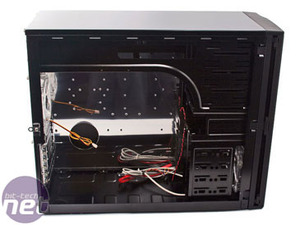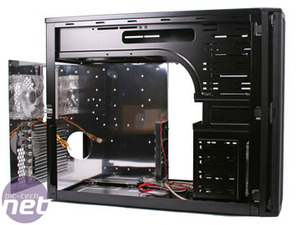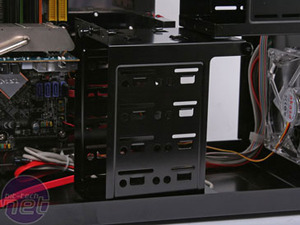Inside the Mirage-62
Back in March I spoke to a representative of a not insignificant case manufacturer, who bemoaned the fact that review websites always mark down cases without removable motherboard trays, and swore that no real user actually needed them.In response to this, I'd like to point out that the Mirage has possibly the best removable motherboard tray I've ever used, and it's a fantastic inclusion that really sets this case from the crowd. Remove the side panels, all of which need just two thumbscrews to undo, and you're immediately faced with half a case of fully removable chromed steel awesomeness, large enough for even an EATX or Skulltrail motherboard.
The entire motherboard mount and rear case plate—exhaust fan and all—slides out on secure rails, with simple thumbscrews to keep the tray in place once reinserted. The difference between building a PC inside a case and using a removable tray is phenomenal, and makes a huge difference for those of who perform frequent upgrades, or aren't so experienced in system building.
I speak from personal experience when I say a good removable motherboard tray is the difference between having a pleasant build experience, and hurling a heatsink away in frustration when it just won't fit. The chrome effect will be down to personal preference – personally I think it looks great, despite being a magnet for finger prints and frustratingly difficult to photograph!
The case layout itself is fairly conventional, with space for five HDDs in a rack behind the front 120mm ventilation fan, and the PSU mounted in the top of the case. All the internal mountings, bar the motherboard tray, are made of the same black aluminium. Unlike the brushed external appearance, these finished in matt, lending the case a feel of consistency of design inside and out.
The five-bay 3.5-inch hard drive rack is fully removable, with two 3.5-inch drives comfortably fitting in the FDD bay as well, which itself is also removable. This level of flexibility is rare in case layouts, and even rarer when combined with the extra internal space afforded by the case's extended width and length, and I can see the Mirage being popular with those dabbling with water cooling who will want to mount pumps or reservoirs in the base of their case.
However, the mechanism for releasing the drive bays is a little unwieldy, with a fairly good tug required to pull the cages free, and I just can't understand why in a case full of thumbscrews, Akasa chose to use such inelegant way of removing the cages. I also discovered that the hard drive cage couldn't be removed once a fairly large graphics card had been installed (see pic below), and although a minor annoyance, no one wants to pull their PC apart to do something as simple as swap a hard drive.
Cable management inside the Mirage is made simple with the luxury of the extra space that's a direct result of its XXL dimensions. I built our test machine using a non-modular power supply and, thanks to more than an inch of clearance either side of the fitted PSU, it was easily able to stash the extra power cables out of sight. The PSU mounting bracket is capable of supporting even the meatiest of 1kW+ power supplies, and the top of the case is completed with a removable clamp bracket for further securing monster power supplies.
The front panel cables are also easily tidied, by being completely removable, so if you don't think you'll be using Firewire or front panel Audio, just disconnect them – you no longer have to try and hide those cables away. This is a great idea that I can't believe we haven't seen before, and I'm hoping it will soon be replicated in other cases – especially smaller ones where hiding cables can be a real nuisance. The Mirage also helps with those cables you do keep by including adjustable reusable cable clips behind the HDD cage – another minor inclusion that can make building a tidy case that much easier.
One thing that is very clear about the Mirage's internals is how much space there is. This is seriously the aircraft hanger of cases, and you could comfortably fill it with seven hard drives, multiple graphics cards, and still have room to move cables or fit a water cooling pump or reservoir. Rather than compartmentalise the interior, as we've seen with cases like the Lian Li PC V-1110, or Antec P190, Akasa has kept it simple and let the user decide how to use the interior of its case. Want to pull the hard drive cages out and mount a six-inch Master Chief Action Figure in there? No problem!
Cooling wise, the Mirage has front and back mounts for 120mm cooling fans, both of which are provided by Akasa, but sadly there's no pre-built scope for additional cooling. While those brave enough to grab a Dremel will have no trouble finding space for extra 120mm side, roof, or even floor intakes/outtakes, it would have been nice to see Akasa think outside the box a little and give us the option to fit extra cooling if we wanted. However, I was happy to see the addition of a removable dust filter for the front 120mm intake - a useful addition for those who value the cleanliness of thier case. The fans themselves are clear acrylic Akasa branded affairs, spinning at 1,200 RPM at full speed, and we'll take a further look into their cooling and noise levels in testing.

MSI MPG Velox 100R Chassis Review
October 14 2021 | 15:04













Want to comment? Please log in.